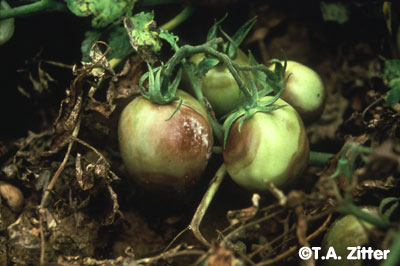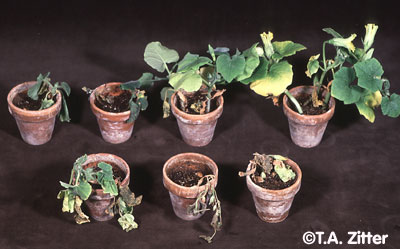The effects of mycorrhizas
The major advantage that a mycorrhizal association confers to plant and fungus is the enhanced supply of nutrients that would not normally available to plant roots. Carbon, phosphorus and nitrogen are transferred in the largest quantities, and these are discussed in the nutrients section.
However, mycorrhizas also have other beneficial effects, especially for the plant partner. Mineral nutrients such as potassium, calcium, copper, zinc and iron are also assimilated more quickly and in greater amounts by mycorrhizal plants. The fungal sheath can also aid plants growing in soils with high concentrations of heavy metals. Zinc, cadmium and arsenic have both been found in high concentrations in fungal sheaths and it is thought that certain mycorrhizal isolates accumulate and immobilise heavy metals in hyphae of their fungal sheaths. In this way, metals are unable to reach plant tissues and the plant remains undamaged.
Arbuscular mycorrhizal (AM) inoculation has also been shown to increase plant resistance to pathogen attack, in particular to pathogenic root infecting fungi, such as Phytophthora parasitica and Fusarium oxysporum. Fig. 1 shows Phytophthora blight of tomato, also known as buckeye rot, showing sporulation on the fruit surface.
 |
| Fig. 1. Phytophthora blight of tomato, also known as buckeye rot, showing sporulation on the fruit surface. Phytophthora infection. © T.A. Zitter with permission. |
Most root pathogenic fungi infect roots much faster than AM fungi, and hence simaltaneous infection often leads to the mycorrhiza being outcompeted. However, if the association is already established, pathogenic infection is much reduced.
AM tomato plants infected with Fusarium showed only 9% necrotic roots compared to 32% in non-AM plants (Fig. 2). Similarly, AM infection can also reduce nematode attacks; cotton seed yield is reduced by 45% in plants infected with the nematode Meloidogyne incognita, but AM inoculation reduced yield loss to 25%. Little is known about the mechanisms behind increased pathogen resistance, although it has been suggested that increased lignification of cell walls or the production of phytoalexins by the plant in response to AM inoculation may be responsible.
 |
| Fig. 2. Response of different cucurbit species to infection with Fusarium solani f. sp. cucurbitae. Mycorrhizal inoculation could reduce damage such as this. © T.A. Zitter with permission. |
Reduction of pathogenic infection by AM inoculation has only been seen with soil-borne pathogens, and infection by air-borne fungi and viruses can be increased by AM inoculation.
Protection against root pathogens is even more effective in ectomycorrhizal (ECM) roots. ECM may use one or more of several strategies to reduce pathogen attack:
- excretion of antifungal and antibiotic substances - 80% of Trichloma spp. produce antibiotics and Boletus and Clitocybe produce antimycotic substances;
- stimulation of other microorganism, which themselves limit pathogens;
- production of antibiotics by the plant, under the control of the mycorrhizal fungi;
- structural protection of the root by the thick fungal coat, the mechanical barrier of the sheath gives very effective protection, since pathogens attack plant tissue and cannot infect fungal tissue.
Mycorrhizal fungi can also benefit plants by increasing their tolerance to adverse conditions. Growth by ECM pines can continue on soil with pH that is lower, and soil temperature that is higher, than non-ECM pines can withstand. Similarly, water stress can be reduced by mycorrhizal infection, by tapping soil water reserves. The extended mycelial zone can take up water from deeper in the soil and hence prolong the time before wilting. Crucially, all fungi can grow at water potential levels lower than those that plants can tolerate. This means that the fungi remain metabolically active, and scavenging for water and nutrients in conditions where plants would cease to grow. Mycorrhizal plants can therefore continue to grow in conditions where non-mycorrhizal plants would wilt and die.
 |
| Fig. 3. Desert ecosystems are often strongly mycorrhizal. © Justin Gould with permission. |
Many common desert plants, including cacti, are heavily mycorrhizal (Fig. 3) indicating that mycorrhizas have a particularly important role in water relations in dry ecosystems and in soils with poor water retention.
Mycorrhizas may affect the ecology of whole plant communities as well as individual plants. This is particularly relevant to ECM and AM, which show very low host specificity, allowing a single fungus to infect several plants in one area (thereby creating a mycorrhizal community), and also several different fungi to infect a single plant.
This allows a mycorrhizal network to establish, which may link many different plants and species within a single habitat.
This network lets carbon and mineral nutrients flux between plants via their common fungi. This can allow seedlings to be supported by their parent plant whilst it is establishing itself (common in forest trees). This spares the seedling the loss of carbon to its fungus, which is particularly important for seedlings since fungi take at least 10% of photosynthates and seedlings have a low photosynthetic capacity. Receiving carbon via the mycelial network can also allow seedlings to establish in less favourable conditions, such as shading, where they would normally be outcompeted by mature plants. This mycorrhizal network in forest systems has been dubbed the wood-wide web.
Non-mycorrhizal plants would be at a distinct disadvantage at the seedling stage especially, and would have to colonise disturbed habitats instead. Indeed, previously uncolonised habitats with few other plants and no mycorrhizas are exactly where the plants of non-mycorrhizal families are commonly found.
Find out more about nutrient exchange in mycorrhizas or their commercial applications by clicking on the hyperlinked phrases.
Further information about mycorrhizas can be found in the new textbook 21st Century Guidebook to Fungi by David Moore, Geoffrey D. Robson & Anthony P.J. Trinci. Published 2011 by Cambridge University Press: ISBN: 9780521186957. URL: ttp://www.cambridge.org/gb/knowledge/isbn/item6026594/?site_locale=en_GB. View Amazon page.
Updated December 15, 2016
